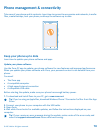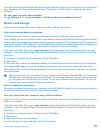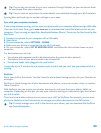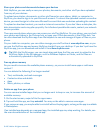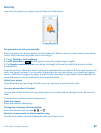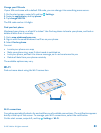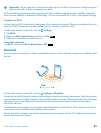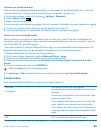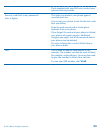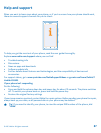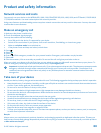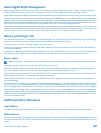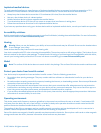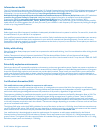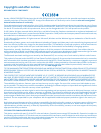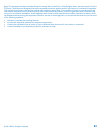Information on health
The U.S. Food and Drug Administration (FDA) and the U.S. Federal Communications Commission (FCC) published statements and
questions and answers concerning mobile telephones and health. Nokia encourages you to visit these websites for updated
information. You can access the FDA website at www.fda.gov/Radiation-EmittingProducts/
RadiationEmittingProductsandProcedures/HomeBusinessandEntertainment/CellPhones/default.htm and the FCC website at
transition.fcc.gov/oet/rfsafety/rf-faqs.html. Additional health-related information is available from the World Health
Organization (WHO) at www.who.int/mediacentre/factsheets/fs193/en/ and The National Cancer Institute ("NCI")
www.cancer.gov/ncicancerbulletin/NCI_Cancer_Bulletin_092308/page7. In the event that you are concerned about possible
health effects, the FDA suggests that you limit your own or your children’s radio frequency (RF) exposure by limiting the length
of calls or by using handsfree devices.
Vehicles
Radio signals may affect improperly installed or inadequately shielded electronic systems in vehicles. For more info, check with
the manufacturer of your vehicle or its equipment.
Only qualified personnel should install the device in a vehicle. Faulty installation may be dangerous and invalidate your warranty.
Check regularly that all wireless device equipment in your vehicle is mounted and operating properly. Do not store or carry
flammable or explosive materials in the same compartment as the device, its parts, or accessories. Do not place your device or
accessories in the air bag deployment area.
Safety while driving
Obey all local laws. Always keep your hands free to operate the vehicle while driving. Your first consideration while driving should
be road safety.
Cellular Telecommunications & Internet Association (CTIA) has also published further info and tips on safe driving at
www.ctia.org/consumer_info/safety, which we encourage you to review. Users located in the U.S. may also call 1-888-901-SAFE
for more info.
Potentially explosive environments
Switch your device off in potentially explosive environments, such as near gas station pumps. Sparks may cause an explosion or
fire resulting in injury or death. Note restrictions in areas with fuel; chemical plants; or where blasting operations are in progress.
Areas with a potentially explosive environment may not be clearly marked. These usually are areas where you are advised to
switch your engine off, below deck on boats, chemical transfer or storage facilities, and where the air contains chemicals or
particles. Check with the manufacturers of vehicles using liquefied petroleum gas (such as propane or butane) if this device can
be safely used in their vicinity.
Certification information (SAR)
This mobile device meets guidelines for exposure to radio waves.
Your mobile device is a radio transmitter and receiver. It is designed not to exceed the limits for exposure to radio waves
recommended by international guidelines. These guidelines were developed by the independent scientific organization ICNIRP
and include safety margins designed to assure the protection of all persons, regardless of age and health.
The exposure guidelines for mobile devices employ a unit of measurement known as the Specific Absorption Rate or SAR. The
SAR limit stated in the ICNIRP guidelines is 2.0 watts/kilogram (W/kg) averaged over 10 grams of tissue. Tests for SAR are
conducted using standard operating positions with the device transmitting at its highest certified power level in all tested
frequency bands. The actual SAR level of an operating device can be below the maximum value because the device is designed
to use only the power required to reach the network. That amount changes depending on a number of factors such as how close
you are to a network base station.
The highest SAR value under the ICNIRP guidelines for use of the device at the ear is 1.24 W/kg. Use of device accessories may
result in different SAR values. SAR values may vary depending on national reporting and testing requirements and the network
band. Additional SAR information may be provided under product information at www.nokia.com.
Your mobile device is also designed to meet the requirements for exposure to radio waves established by the Federal
Communications Commission (USA) and Industry Canada. These requirements set a SAR limit of 1.6 W/kg averaged over one
gram of tissue. The highest SAR value reported under this standard during product certification for use at the ear is 1.51 W/kg
and when properly worn on the body is 1.30 W/kg.
© 2013 Nokia. All rights reserved.
91



